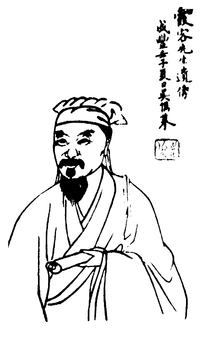Xu Xiake
Xu Xiake | |
|---|---|
 Portrait of Xu Xiake | |
| Born | Xu Hongzu 5 January 1587 |
| Died | 8 March 1641 (aged 54) |
| Occupation(s) | Explorer,geographer,travel writer |
| Xu Xiake | |||||||||||||||||||
|---|---|---|---|---|---|---|---|---|---|---|---|---|---|---|---|---|---|---|---|
| Chinese | Từ hà khách | ||||||||||||||||||
| |||||||||||||||||||


Xu Xiake(Chinese:Từ hà khách;pinyin:Xú Xiákè;Wade–Giles:Hsü Hsia-k'o,January 5, 1587 – March 8, 1641), bornXu Hongzu(Từ hoằng tổ),courtesy nameZhenzhi(Chấn chi), was a Chinese explorer,geographer,andtravel writerof theMing dynasty,known best for his famous geographical treatise, and noted for his bravery and humility. He traveled throughout China for more than 30 years, documenting his travels extensively. The records of his travels were compiled posthumously inThe Travel Diaries of Xu Xiake,and his work translated by Ding Wenjiang.[1]Xu's writing falls under the old Chinese literary category of 'travel record literature' ('youji wenxue' “Du ký văn học” ), which usednarrativeandprosestyles of writing to portray one's travel experiences.[2]
ThePeople's Liberation Army Navybarracks shipXu Xiakewas named after him.
Life[edit]
With ancestors fromJiangxiprovince, Xu Xiake was born in what is todayJiangyin(inJiangsuprovince) as Xu Hongzu (Hoành tổ), as the second son of Xu Yu'an ( từ dự am, 1545–1594) and Wang Ruren ( vương nhụ nhân, 1545–1625). It was often said his mother encouraged him to travel and this shaped Xu's predilections. His sobriquet is Zhenzhi (Chấn chi).Xiakewas an alternatesobriquet(Biệt hào) given to him by his friend Chen Jiru ( trần kế nho, 1558–1639) and it means "one who is in the sunset clouds". His other friend,Huang Daozhou( hoàng đạo chu, 1585–1646), also gave Xu an alternate sobriquet:Xiayi(Hà dật), meaning "untrammelled in the sunset clouds."
On his journeys throughout China he travelled with a servant called Gu Xing (Cố hành). He faced many hardships along the way, as he was often dependent on the patronage of local scholars who would help him after he had been robbed of all his belongings.[1]Local Buddhist abbots of the various places he visited often would pay him money as well, for the small service of recording the history of their local monastery.[1]From the snowy passes ofSichuan,to the subtropical jungles ofGuangxiandYunnan,to the mountains ofTibet,Xu Xiake wrote of all his experiences and provided enormous amounts of written detail from his observations.
Travel records[edit]

The written work of Xu Xiake's travel records and diaries contained some 404,000Chinese characters,an enormous work for a single author of his time.[3]Xu traveled throughout the provinces of China, often on foot, to write his enormous geographical andtopographicaltreatise, documenting various details of his travels, such as the locations of small gorges, ormineralbeds such asmicaschists.[4]Xu's work was quite systematic, providing accurate details of measurement, and his work, later translated into modern Chinese byDing Wenjiang,reads more like the accounts of a 20th-century field surveyor than an early 17th-century scholar.[4]InGuizhou,he made the discovery of the true source of theWest River.He also discovered theMekongandSalweenrivers were, in fact, separate drainages with completely separate watersheds.[4]Xu made the important realization that theJinsha rivernetwork – and not theMinorYalong– formed the true headwaters of theYangtze River,correcting a mistake in Chinese geography as old as the "Tribute of Yu"compiled byConfuciusin theClassic of History.[4]
Notes[edit]
References[edit]
- Hargett, James M. "Some Preliminary Remarks on the Travel Records of the Song Dynasty (960–1279)," Chinese Literature: Essays, Articles, Reviews (July 1985): 67–93.
- Ward, Julian, and Hongzu Xu. 2001. Xu Xiake (1587–1641): the art of travel writing. Richmond [England]: Curzon.ISBN0-7007-1319-0.
- Needham, Joseph(1959).Science and Civilisation in China: Mathematics and the Sciences of Heaven and Earth.Vol III (Cambridge University Press, 1959).
- Hummel, Arthur W. Sr.,ed. (1943)..Eminent Chinese of the Ch'ing Period.United States Government Printing Office.
External links[edit]
- Xu Xiake bio at Chinaculture.org
- "Travel Diary of Xu Xiake ( từ hà khách du ký )"(in Chinese). open-lit.com.RetrievedJanuary 11,2014.
